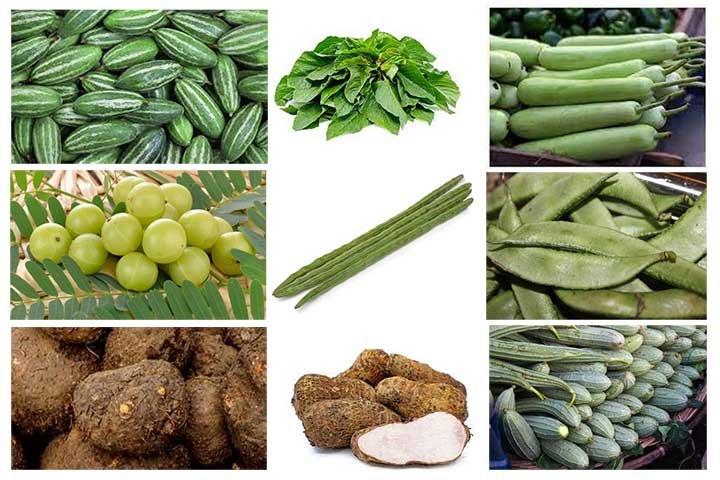India is a country of diverse cultures, languages, and cuisines. The Indian subcontinent is known for its rich and varied food culture. The country boasts of several rare and unique vegetables that are not commonly found in other parts of the world. These vegetables are not only delicious but are also rich in nutrients and have several health benefits. In this article, we will discuss some of the rare vegetables in India.
-
Taro Root
Taro root, also known as Arbi, is a starchy vegetable that is commonly found in India. It is a root vegetable that belongs to the family of Araceae. The plant is grown for its underground tubers, which are boiled, roasted, or fried before consumption. Taro root is rich in fiber, potassium, and vitamin C. It is also known for its low glycemic index, which makes it a good option for people with diabetes.
-
Snake Gourd
Snake gourd, also known as Padavalanga, is a long, cylindrical vegetable that is commonly found in India. It is a climbing plant that belongs to the Cucurbitaceae family. The vegetable is known for its unique shape and taste. Snake gourd is rich in antioxidants, vitamins, and minerals. It is also known for its anti-inflammatory properties, which makes it a good option for people suffering from inflammation-related conditions.
-
Elephant Foot Yam
Elephant foot yam, also known as Suran, is a large, bulbous vegetable that is commonly found in India. It is a root vegetable that belongs to the family of Araceae. The vegetable is known for its starchy texture and unique taste. Elephant foot yam is rich in fiber, potassium, and vitamin B6. It is also known for its anti-inflammatory properties, which makes it a good option for people suffering from inflammation-related conditions.
-
Bottle Gourd
Bottle gourd, also known as Lauki or Doodhi, is a long, cylindrical vegetable that is commonly found in India. It is a climbing plant that belongs to the Cucurbitaceae family. The vegetable is known for its mild taste and high nutritional value. Bottle gourd is rich in fiber, vitamins, and minerals. It is also known for its low calorie and low-fat content, which makes it a good option for people looking to lose weight.
-
Colocasia
Colocasia, also known as Arbi or Taro, is a root vegetable that is commonly found in India. It is a member of the Araceae family and is grown for its edible corms. Colocasia is rich in fiber, potassium, and vitamin C. It is also known for its anti-inflammatory properties, which makes it a good option for people suffering from inflammation-related conditions.
-
Indian Broad Beans
Indian Broad Beans, also known as Papdi, is a legume that is commonly found in India. It is a climbing plant that belongs to the Fabaceae family. The vegetable is known for its unique taste and high nutritional value. Indian Broad Beans is rich in protein, fiber, vitamins, and minerals. It is also known for its low calorie and low-fat content, which makes it a good option for people looking to lose weight.
-
Amaranth Leaves
Amaranth leaves, also known as Chaulai, are green leafy vegetables that are commonly found in India. It is a member of the Amaranthaceae family and is grown for its edible leaves. Amaranth leaves are rich in iron, calcium, and vitamin C. They are also known for their anti-inflammatory properties, which makes them a good option for people suffering from inflammation-related conditions.
-
Indian Gooseberry
Indian gooseberry, also known as Amla, is a fruit that is commonly found in India. It is a small, green fruit that is rich in vitamin C and antioxidants. Indian gooseberry is known for its medicinal properties and is used in traditional Ayurvedic medicine for its various health benefits. The fruit is used to boost immunity, improve digestion, and promote hair and skin health.
-
Drumstick
Drumstick, also known as Sahjan, is a long, green vegetable that is commonly found in India. It is a member of the Moringaceae family and is grown for its edible pods. Drumstick is rich in vitamins, minerals, and antioxidants. It is also known for its anti-inflammatory properties, which makes it a good option for people suffering from inflammation-related conditions.
-
Pointed Gourd
Pointed gourd, also known as Parwal, is a vegetable that is commonly found in India. It is a climbing plant that belongs to the Cucurbitaceae family. The vegetable is known for its unique shape and taste. Pointed gourd is rich in fiber, vitamins, and minerals. It is also known for its low calorie and low-fat content, which makes it a good option for people looking to lose weight.
Pros and Cons of rare vegetables in India
here are some pros and cons of the rare vegetables mentioned in the article:
Pros:
- Nutritional Value: Rare vegetables are rich in nutrients, vitamins, and minerals that are essential for maintaining good health. Including these vegetables in your diet can help you meet your daily nutrient requirements.
- Unique Taste: Rare vegetables have a unique taste that sets them apart from the common vegetables that we consume on a regular basis. Trying out new and unique vegetables can help you explore different flavors and tastes.
- Health Benefits: Rare vegetables have several health benefits that can help you prevent various diseases and conditions. For example, the anti-inflammatory properties of elephant foot yam, drumstick, and amaranth leaves can help reduce inflammation in the body.
- Variety: Including rare vegetables in your diet can help you add variety to your meals. Eating the same vegetables every day can get boring, but trying out new and unique vegetables can make your meals more interesting and exciting.
Cons:
- Availability: Rare vegetables are not commonly found in supermarkets or grocery stores, which can make them difficult to find. This can be a problem for people who live in areas where these vegetables are not easily available.
- Price: Rare vegetables can be more expensive than common vegetables, which can make them less affordable for some people. This can be a problem for people who are on a tight budget.
- Preparation: Some rare vegetables require special preparation techniques, which can be time-consuming and difficult. For example, taro root needs to be boiled, roasted, or fried before consumption, which can be a hassle for some people.
- Taste: While rare vegetables have a unique taste, they may not be everyone’s cup of tea. Some people may not like the taste of certain rare vegetables, which can be a problem if you are trying to incorporate them into your diet.
while rare vegetables have several pros, such as nutritional value, unique taste, health benefits, and variety, they also have some cons, such as availability, price, preparation, and taste. It is up to the individual to weigh these pros and cons and decide whether or not to include rare vegetables in their diet.
In conclusion
India is a land of diverse cultures, languages, and cuisines. The country boasts of several rare and unique vegetables that are not commonly found in other parts of the world. These vegetables are not only delicious but are also rich in nutrients and have several health benefits. Taro root, snake gourd, elephant foot yam, bottle gourd, colocasia, Indian broad beans, amaranth leaves, Indian gooseberry, drumstick, and pointed gourd are some of the rare vegetables in India that are worth trying. Including these vegetables in your diet can help you stay healthy and fit.








